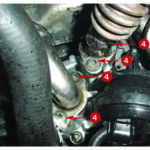Peter Lowery, senior product manager, SMPE talks us through EGR valve removal. How to cut down your labour time: time saving tips for VW 1.6D & 2.0D engines.
With a book time of around 4.5 hours, EGR valve replacement on VW 1.6D and 2.0D engines can be a long and time-consuming process. As one of the many parts that we’ve developed for remanufacture at SMPE we’ve regularly fitted this component to test cars. Through that experience we now believe we’ve found a quicker way of getting the job done.
1.6D AND 2.0D ENGINES COVERED: CAYB, CAYC, CAYD, CAYE, CFFA, CFFB, CFGB, CFGC, CFGD, CFHA, CFHB, CFHC, CFHF, CFJA, CLCA, CLCB, CLLA, CLLB
EGR valve removal
Remove the particulate filter and downpipe (note: on certain models only it may be possible to remove the EGR valve without removing the DPF, however you SHOULD NOT attempt this if you’re not confident). Disconnect the crankcase breather hose (1) and detach the air pipe from the air filter housing (2). Now move the air hose and connection to the rear and detach from the turbocharger (3).
Remove the bolts (4) and detach the exhaust gas recirculation pipes. Use the new gaskets provided on reassembly. Remove the bolts and banjo bolt then detach the support for the turbocharger with the oil supply line (5). Use the new gasket provided on reassembly (only applicable to some models). Clamp off the coolant hoses then disconnect from the EGR valve. Now remove the attachment bolts and then the EGR valve.
Refitting is the reverse of the removal process. Top up coolant as necessary and, after fitting, use the appropriate diagnostic equipment to clear any fault codes and ensure the ECU is updated with the latest software issue. Switch off the ignition for at least 30 seconds, then start the engine and allow it to idle until it reaches normal operating temperature.
The new EGR valve base settings should now have been learned. The engine may run slightly uneven for approximately 50 miles, until the ECU fully learns the adaptive parameters of the new EGR valve.

Our remanufacturing process
All components are stripped, cleaned of carbon deposits, inspected for wear, and replaced where necessary. A new SMPE in- house manufactured PCB with custom designed electronics is fitted to the motor assembly and all components are reassembled before the unit is calibrated and tested – this procedure accurately calibrates the electronic feedback of the valve. The coolant section is then pressure tested to detect any leaks. The final test is to flow gasses through the unit at various pressures and rates to ensure the correct electronic signal is produced.










